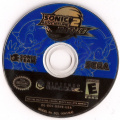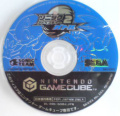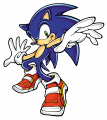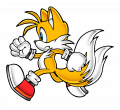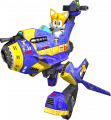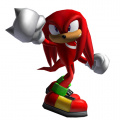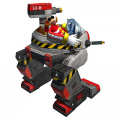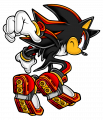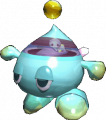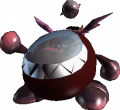Sonic Adventure 2: Battle
From Sonic Retro
Revision as of 02:15, 6 December 2009 by SonicAngel948 (talk | contribs) (→Differences Between Dreamcast and GameCube Versions: *confused Rouge's halloween outfit with second skin*)
| Expression error: Unexpected < operator. |
| Sonic Adventure 2: Battle |
|---|
| System(s): Nintendo GameCube |
| Publisher: Sega |
| Developer: Sonic Team |
| Genre: 3D Platform |
</div>
Sonic Adventure 2: Battle is an upgraded port of the Sega Dreamcast's Sonic Adventure 2 for the Nintendo GameCube. It was the first Sonic game to be released on a Nintendo console. Ironically, this version of the game did not get as good reviews as its Dreamcast predecessor.
Contents
Differences Between Dreamcast and GameCube Versions
A title sequence was added before the game's title appears. The Dreamcast version just goes straight to the title screen.
New "Battle" multiplayer options have been added, and characters that needed to be unlocked in the original are now unlocked from the start. The requirements to unlock these characters were instead used to unlock new features for the Kart mode.
Some special effects were added to the versus mode and characters. The former unlockable characters were given new stats, moves, sound effects and animations instead of being clones like the Dreamcast version. The most notable of these are that Metal Sonic now has no distance attacks, and Chaos' time freeze ability lasts for a whopping 30 seconds. The special attacks were also given an anime styled flashing background (which also appears in the 1P boss battles. The secret character skins were also changed.
Minor special effects were added to the game, such as rain in White Jungle. Although, some special effects were also removed from the game, such as the red lights that flash during Iron Gate. The characters during play mode were also slightly modified with better shading. Moreover, some cutscenes were redone slightly, with different or improved character animations and camera angles. However, many of the cast shadows were removed. Quite noticeably, the cutscenes appear to play faster than on its original Dreamcast counterpart.
Strangely, Big the Cat's humorous cameos did not remain in the stages, but he can still be viewed in some story sequences by rapidly pressing the ![]() button throughout the scenes. He no longer appears in the Hero Side story, however, which means he is not in Sonic's opening scene in any form. He was also replaced by the Dark Chao Walker in the game's multiplayer mode.
button throughout the scenes. He no longer appears in the Hero Side story, however, which means he is not in Sonic's opening scene in any form. He was also replaced by the Dark Chao Walker in the game's multiplayer mode.
Another difference in this version can be found on the 5th Mission for the Cosmic Wall stage: 100,000 points are required for an A rank rather than the mere 50,000 required in the Dreamcast version. The boxes in Crazy Gadget also have red "x"'s instead of green. This may have been changed due to the Xbox logo being so similar to the marking.
This game also changed a large portion of raising Chao, the Artificial life form available in both Sonic Adventure and Sonic Adventure 2. Unlike the Dreamcast version, where a VMU was required to view a Chao's statistics, that information can now be viewed from within the game. The player can also transfer one Chao from Sonic Adventure 2: Battle to Sonic Advance, Sonic Advance 2, and Sonic Pinball Party with a GCN-GBA Link Cable. The Tiny Chao Garden minigame can be downloaded from the game to a GBA. This version also included Chao Karate, a fighting-style game using a Chao's stats with little influence from the player. The layouts of all three Chao Gardens were changed slightly.
During treasure hunting missions, a red exclamation point was added to notify the player that they were very close to an emerald/key.
Manuals
- Sonic Adventure 2: Battle US Manual
- Sonic Adventure 2: Battle EU Manual
- Sonic Adventure 2: Battle JP Manual
Production Credits
Executive Producer: Isao Okawa
Producer: Yuji Naka
Director: Takashi Iizuka
Art Director: Kazuyuki Hoshino
Main Programmer: Tetsu Katano
Scenario Writer: Shiro Maekawa
Chao Director: Sachiko Kawamura
Sound Director: Jun Senoue
Assistant Director: Keith Palmer
Player Character Designers: Kazuyuki Hoshino, Yuji Uekawa
Player Character Programmer: Tetsu Katano
Field Designers (Level Designers): Takashi Iizuka, Eitaro Toyoda
Camera System Programmer: Takeshi Sakakibara
Field Programmers: Kouji Ogino, Tomoyuki Naito
Field Art Director: Hiroshi Nishiyama
Field Artists: Nobuhiko Honda, Daizo Kinoshita, Takahiro Kudo, Yoshitaka Miura
Enemy Game Designers: Takashi Iizuka, Eitaro Toyoda
Enemy Programmers: Tetsu Katano, Makiko Nishimura, Tomoyuki Naito
Enemy Character Designers: Kazuyuki Hoshino, Nobuhiko Honda
Story Event Designer: Shiro Maekawa
Lead Event Artist: Michikazu Tamamura
Event Scene Artists: Mika Okada, Atsushi Saito, Nanako Yarimizu, Makoto Yonezu
Story Event Programmer: Takeshi Sakakibara
Chao Main
Lead Chao Programmer: Yoshihisa Hashimoto
Chao Programmers: Takaaki Saito, Makiko Nishimura
Lead Chao Artists: Sachiko Kawamura
Chao Artists: Kazuko Ito, Makoto Yonezu
Chao Program Support: Masanobu Yamamoto, Yoshitaka Kawabata, Masakazu Miura, Yusuke Masuo
Tiny Chao Garden
Tiny Chao Garden Product Coordinator: Akinori Nishiyama
Tiny Chao Garden Game Designers: Sachiko Kawamura, Yoshihisa Hashimoto
Tiny Chao Garden Lead Programmer: Takahiro Hamano
Tiny Chao Garden Mini Game Programmer: Takaaki Saito
Tiny Chao Garden Artists: Sachiko Kawamura, Kazuko Ito
CG Movie Producer: Keith Palmer
CG Movie Director: Kazuyuki Hoshino
CG Movie Coordinator: Bobby White
CG Movie Production: SUPER 78
Sound Design By: Wave Master Inc.
Executive Sound Coordinator: Yukifumi Makino
Music Composer & Lyrics: Jun Senoue, Kenichi Tokoi, Fumie Kumatani, Tomoya Ohtani
Lyrics: Johnny Gioeli, Ted Poley, Paul Shortino
Sound Effects: Masaru Setsumaru, Takashi Endoh
Sound Technical Support: Shigeharu Isoda
Sound Effects Programmer: Makiko Nishimura
Music Producers: Jun Senoue, Atsushi Kosugi (Beat On Beat), Heigo Tani, Takayoshi Umeno (Flava Entertainment)
Recording Studios: Wave Master Studio, Cam-am Recorders, Avatar Studio, Planet To Planet, The Owl's Nest, Mit Studio
Recording Engineers: The Riddle, Roy Hendrickson, Kirk Yano, Hirokazu Akashi, Yoshitada Miya, Masahiro Fukuhara (Mit Studio), Chifumi Karasawa (Mit Studio), Satoru Izaki (Mit Studio), Kenji Miyamoto (Attlc Arcade)
Recording Coordinators: Akinori Nishiyama, Atsushi Kosugi (Beat On Beat), Keith Palmer, Moet Nishio (Beat On Beat), Masakazu Hiroishi, Makoto Suzuki (Compozila), Kiyoshi Yoshida (Mit Gatheing)
Master Studios: WMJ Studio
Mastering Engineer: Isao Kikuchi (WMJ Studio)
Singers: Johnny Gioeli, Tony Harnell, Ted Poley, Kaz Silver, Marlon Saunders, 100P, Todd Cooper, Paul Shortino, Everett Bradley, Tabitha Fair
Original Lyrics Translation: Takahiro Fukada
Lyrics Translation: Shinobu Shindo
Motion Capture Studio: Visual Concepts Entertainment Inc.
Motion Capture Supervisor: Matt Karnes
Japanese Character Voices: Jun'ichi Kanemaru, Koji Yusa, Atsuki Murata, Nobutoshi Kanna, Taeko Kawata, Rumi Ochiai, Etsuko Kozakura, Yuri Shiratori, Kinryu Arimoto, Mami Horikoshi, Tohru Okawa, Kouji Ochiai, Kaori Aso, Tomoko Sasaki, Chikao Otsuka
Voice Recording Producer: Hiroyuki Inage (TOHOKUSHINSHA)
Voice Recording Director: Eriko Kimura (TOHOKUSHINSHA), Lani Minella
Recording: OMNIBUS JAPAN
English Character Voices: Ryan Drummond, David Humphrey, Scott Dreier, Conner Bringas, Jenny Douillard, Deem Bristow, Lani Minella, Moriah Angeline, Marc Biagi, Steve Broadie, Sue Wakefield, Elara Distler, Shelly Fox
Voice Recording Editors: Rick Bowman, Lethal Sounds
Voice Recording Operation: Target Laboratory Inc.
Product Support: Akinori Nishiyama, Yuji Uekawa, Masanobu Yamamoto
Library Support: Yoshitaka Kawabata, Sega Ninja Team
Middleware Support: CRI Middleware Co. Ltd., Ryo Goubara, Kengo Mikoshiba, Masao Oshimi, Katsumi Yabuno, Atsishi Sakurai, Manaru Fukuda, Osamu Sato, Takashi Nozawa, Shun Hosaka
Sega Corporation
Executive Management: Hideki Sato, Tetsu Kayama
Promotion Management: Masanao Maeda, Hiroyuki Miyazaki, Seijiro Sannabe, Hideki Yokaichiya, Yasushi Yamashita
Marketing: Mitsuru Takahashi, Takayoshi Ohuchi, Naoko Ooka
Public Relation: Media Communication Team, Mariko Takeda
Manual Production: Yoshihro Sakuta, Takashi Nishimura, Hiroki Osawa
Sega Of America Dreamcast Inc.
Executive Management: Peter Moore
Executive Coordinator: Shinobu Toyoda, Jin Shimazaki
Localization Producer: Osamu Shibamiya
Translators: Kyoko Drumheller, Klayton Vorlick
Lead Tester: Steve Peck
Product Manager: Robert Alvarez
Assistant Product Manager: Cord Smith
Public Relations: Gwen Marker
Sega Europe, Ltd.
Executive Management: Yoshio Sakai
Director Of PD: Kats Sato
Producers Manager: Aude Donnan
Localization Producer: Kuniyo Matsumoto
Lead Tester: Mathew Brooks
Product Marketing Manager: Jim Pride
Product Manager: Mathew Quaeck
Special Thanks: Shinya Matsunami, Yusuke Nasuo, Chie Maekawa, Sawako Sogabe, Greg Thomas, Sandra Castagnola, Greg Drumnller, Jane Thompson, Yukio Aoyama, Keiko Lull, Yojiro Ogawa, Satoshi Okano, Yoshinari Amaike, Shun Nakamura, Kenichi Fujiwara, Hiroyuki Watanabe, Hozomi Yamauchi, Tomoyuki Maruyama, Yasuko Maruyama, Masae Hirosawa
Cooperation With: Soap, MPEG Sofdec, ADX
For production of the original Sonic Adventure 2, see Sonic Adventure 2's Production Credits.

